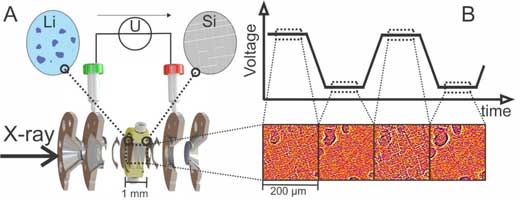| Jul 30, 2020 | |
Researchers follow the charging and discharging of silicon electrodes live(Nanowerk News) Using silicon as a material for electrodes in lithium-ion batteries promises a significant increase in battery amp-hour capacity.The shortcoming of this material is that it is easily damaged by the stress caused by charging and discharging. |
|
| Scientists at the Helmholtz-Zentrum Berlin für Materialien und Energie (HZB) have now succeeded for the first time in observing this process directly on crystalline silicon electrodes in detail (Energy Storage Materials, "Morphological evolution of a single crystal silicon battery electrode during lithiation and delithiation: An operando phase-contrast imaging study"). Operando experiments using the BESSY II synchrotron provided new insights into how fractures occur in silicon – and also how the material can nevertheless be utilised advantageously. | |
 |
|
| The design of the experimental set-up shows how the structure of the silicon electrode periodically changes during charging and discharging on the basis of voltage measurements. (Image: HZB) (click on image to enlarge) | |
| Whether in smartphones or electric cars – wherever mobile electric power needs to be available, it usually comes from rechargeable lithium-ion batteries. One of the two electrodes inside these batteries consists of graphite in which lithium ions are lodged, thereby storing electrical energy. | |
| The disadvantage of this carbon material is that its energy storage capacity is quite small – which makes frequent recharging of the battery necessary. For this reason, researchers worldwide are searching for alternative electrode materials to lengthen the battery charge/discharge cycles. | |
Silicon pushes the storage capacity |
|
| One promising candidate is silicon. This is because it can host more than ten times as many lithium ions as graphite. | |
| “In addition, silicon is one of the most common elements in the earth's crust and is available in almost inexhaustible quantities“, says Dr. Sebastian Risse, who works at HZB on the analysis of storage materials. | |
| A few battery manufacturers are already using tiny silicon particles to improve the energy storage capacity of graphite electrodes. But this trick has its limits. | |
| “When lithium ions are stored, the silicon expands to many times its normal size“, explains Risse. The result: the material gradually becomes cracked. | |
| A team of researchers at HZB led by Sebastian Risse has now examined for the first time at high resolution what happens in detail on electrodes made of crystalline silicon – and followed the physical processes during charging and discharging in real time, just like in a movie. The basis for this is multidimensional operando analysis – a technique that the Berlin researchers have developed in recent years. | |
| “We can use it to measure various properties simultaneously and thus track changes in the shape of the material while the battery is being operated in the usual way“, says Risse. | |
Operation of a battery in coherent X-ray light |
|
| In addition to electrical measurements and images taken with an electron microscope, the Berlin researchers also relied on a method called phase-contrast imaging. | |
| “It uses a coherent X-ray beam that only a synchrotron can deliver“, emphasises Risse. | |
| The physicist and his colleagues used X-ray light from the BESSY II synchrotron storage ring at HZB for their experiments, illuminating an electrode made of crystalline silicon while it ran through several charging and discharging cycles. When illuminated by coherent X-rays – those in which all the X-ray waves oscillate in synchrony – subtleties of material structure lead to characteristic phase shifts in the X-rays. | |
| “This reveals much more observable detail than analysis with normal X-ray light“, says Risse. Dr. Ingo Manke, who heads the Imaging Techniques Group at the HZB Institute for Applied Materials Research, contributed the necessary know-how. | |
| The results of multidimensional high-resolution operando imaging of the crystalline silicon electrodes have provided new insights into the promising system. For example, the researchers were able to show that a checkerboard-like fracture pattern develops and disappears again during charging and discharging. | |
| “Although the fractures become slightly larger each time the electrodes are discharged, the pattern remains the same“, reports Risse. “New fractures do not occur.“ | |
| This is good news for the use of silicon in batteries. Additional hope came from another discovery. The incorporation of lithium ions into the silicon crystal lattice takes place in two steps: first a phase with weakly-charged lithium forms, then a second phase rich in lithium. | |
| The process is reversed when discharging. The Berlin researchers have now discovered that the material only fractures during the second step when the lithium-poor phase is also discharged. | |
Building the foundation for durable power sources |
|
| “If always only a portion of the silicon was used to store the lithium ions, then macroscopic damage to the material might be avoided“, concludes Risse. | |
| And although the lithium-ion batteries with electrodes made of silicon would not be using their full storage capacity, they might store much more energy in comparison to electrodes made of graphite. Cell phones would then have to be plugged in less often, and electric cars could cover longer distances on one battery charge. | |
| “There is still a long way to go before we get there“, says Risse. But the scientific foundation has now been laid. |
| Source: Helmholtz-Zentrum Berlin für Materialien und Energie | |
|
Subscribe to a free copy of one of our daily Nanowerk Newsletter Email Digests with a compilation of all of the day's news. |
